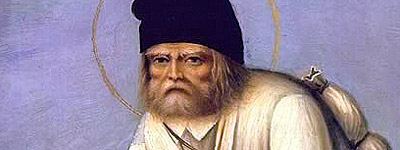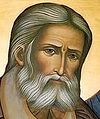

| Previous day | Next day |
| Old Style
July 19
|
Thursday |
New Style
August 1
|
| 6th Week after Pentecost. Tone 4. | No fast.
|
![]() St. Macrina, sister of Sts. Basil the Great and Gregory of Nyssa (380).
St. Macrina, sister of Sts. Basil the Great and Gregory of Nyssa (380). ![]() St. Dius, abbot, of Antioch (ca. 430).
St. Dius, abbot, of Antioch (ca. 430). ![]() Uncovering of the relics of St. Seraphim of Sarov (1903). Synaxis of the Saints of Kursk.
Uncovering of the relics of St. Seraphim of Sarov (1903). Synaxis of the Saints of Kursk.
![]() Blessed Romanus, prince of Ryazan (1270). St. Paisius of the Kiev Caves (14th c.). Blessed Stephen Lazarevic, king of Serbia (1427) and his mother St. Milica (Eugenia in schema) (1405). Sts. Demetrius, metropolitan of Rostov (1709), and Mitrophan (1703) and Tikhon (1783), bishops of Voronezh. St. Sophronius, archimandrite, of Svyatogorsk Monastery (1921).
Blessed Romanus, prince of Ryazan (1270). St. Paisius of the Kiev Caves (14th c.). Blessed Stephen Lazarevic, king of Serbia (1427) and his mother St. Milica (Eugenia in schema) (1405). Sts. Demetrius, metropolitan of Rostov (1709), and Mitrophan (1703) and Tikhon (1783), bishops of Voronezh. St. Sophronius, archimandrite, of Svyatogorsk Monastery (1921).
Icon of the Most Holy Theotokos “Umileniye” (“Of Tender Feeling”) of Diveyevo, before which St. Seraphim reposed.
St. Theodore, bishop of Edessa (848). Abba Diocles of the Thebaid. Rightbelieving Princess Jelena (Balsic) Lazareva of Serbia (1443).
Repose of Hieroschemamonk Anthony of Valaam (1862), Blessed Abbot Nilus (1870) and Elder John (1903), both of St. Nilus of Sora Monastery, and Archimandrite Nektary (Chernobyl) of Jerusalem (2000).
Articles
 Venerable Dius, Abbot of AntiochSaint Dius doctored the infirm with prayer, and whatever was offered him he distributed to the poor, the homeless and the sick. |
 St. Seraphim of Sarov |
 Modern Miracles of St. Seraphim of SarovThe following are true stories sent by readers to the editors of Pravoslavie.ru. |
 Right-believing Prince Roman of RyazanRoman Olegovich was summoned to the Horde, where Khan Mengu-Timur declared that he had to choose one of two things: either a martyr’s death or the Tatar faith. |
 Venerable Paisius of the Kiev Far CavesSaint Paisius of the Caves was a monk of the Kiev Caves monastery. |
 Blessed Stephen, King of SerbiaIn the terrible times of the Turkish Yoke Saint Stephen became the great benefactor of his enslaved countrymen. |
 Holy Right-believing Princess Militsa of SerbiaSaint Militsa founded Ljubostinja monastery around 1390, and there in 1393, she was tonsured as a nun with the name Eugenia. |
















